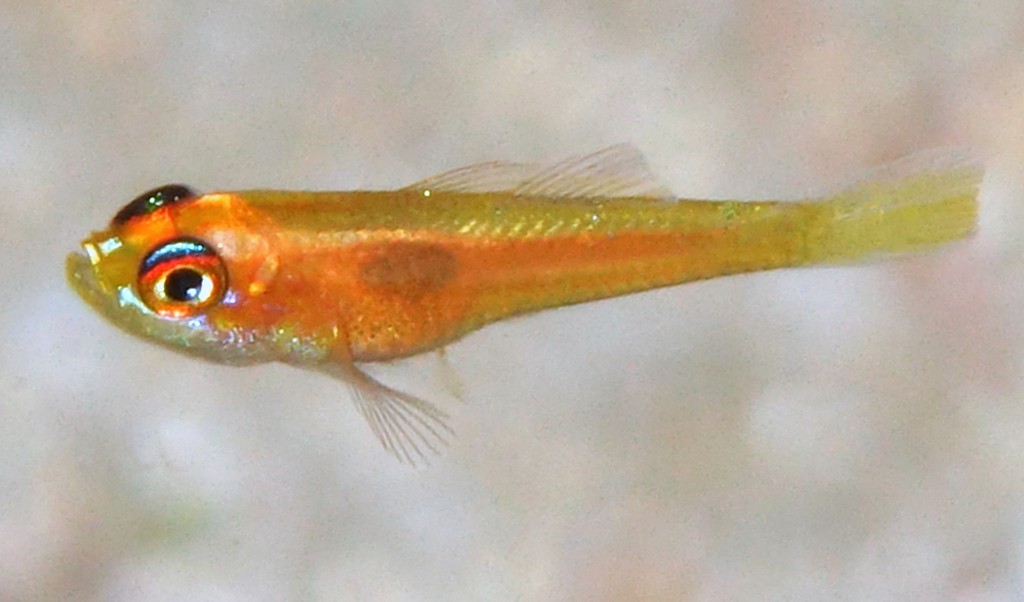TRIMMA ANAIMA - (WINTERBOTTOM, 2000)
Picture courtesy of: Alain Daoulas
Biology
Inhabits coastal reef slopes and lagoons. Found along reef margins with rubble. Also found in caves and crevices, often on drop-offs. A relatively rare species in collections, usually been taken in lots of one or two specimens.
Actinopterygii (Gigaclass) > Actinopteri (Class) > Teleostei (Subclass) > Gobiiformes (Order) > Gobioidei (Suborder) > Gobiidae (Family) > Gobiinae (Subfamily) > Trimma (Genus)
Trimma anème, Pallid pygmygoby, Pale dwarfgoby, Pale dwarfgoby, Sharp-eye pygmy-goby, Sharpeye pygmygoby, Himeni rami benibaze, ヒメニラミベニハゼ,
Synonyme
Trimma amaima (Winterbottom, 2000)
--------------------------
Description
Dorsal spines (total): 6-7; Dorsal soft rays (total): 8; Anal spines: 1; Anal soft rays: 8; Longitudinal scale series: 23; Depth of body: 4.0-4.1 in SL. A bony interorbital about 2/3 pupil diameter in width and only slightly concave; Absence of troughs or trenches in the interorbital or posterodorsal orbital regions; Unbranched fifth pelvic-fin ray, 50-60% fourth ray; Epaxialis extending anteriorly to a vertical in line with the posterior margin of the orbit; No elongated spines; All pectoral rays unbranched; Absence of predorsal scales on midline; 1-2 deciduous scales on upper opercle. Max. length: 3.0 cm SL. Depth range: 3 - 35 m.
Color
Semi-translucent pink on upper half of body (straw-yellow, translucent above midlateral septum); Midlateral stripe is broad and reddish orange in color; Breast and belly, white; Narrow light blue lines below eye, dorsal midline of snout and behind upper rear corner of eye.
Etymology
Trimma: from Greek, trimma, -atos = something crushed.
anaima: from ancient Greek, anaimos = bloodless, pallid, pale or anaemic. Referring to the pale, almost washed-out coloration of the species.
Original description: Trimma anaima Winterbottom, 2000 - Type locality: off Al Almal hotel just east of Matsumudu, 12°09'30"S, 44°24'00"E, Anjouan Island, Comoro Islands, southwestern Indian Ocean, depth 6 - 18 meters.
Distribution
Indo-West Pacific: Amirantes, Comoro Islands and Maldives east to Indonesia, north to Philippines, south to Great Barrier Reef (Queensland, Australia) and New Caledonia.
Trimma amaima (Winterbottom, 2000)
--------------------------
Description
Dorsal spines (total): 6-7; Dorsal soft rays (total): 8; Anal spines: 1; Anal soft rays: 8; Longitudinal scale series: 23; Depth of body: 4.0-4.1 in SL. A bony interorbital about 2/3 pupil diameter in width and only slightly concave; Absence of troughs or trenches in the interorbital or posterodorsal orbital regions; Unbranched fifth pelvic-fin ray, 50-60% fourth ray; Epaxialis extending anteriorly to a vertical in line with the posterior margin of the orbit; No elongated spines; All pectoral rays unbranched; Absence of predorsal scales on midline; 1-2 deciduous scales on upper opercle. Max. length: 3.0 cm SL. Depth range: 3 - 35 m.
Color
Semi-translucent pink on upper half of body (straw-yellow, translucent above midlateral septum); Midlateral stripe is broad and reddish orange in color; Breast and belly, white; Narrow light blue lines below eye, dorsal midline of snout and behind upper rear corner of eye.
Etymology
Trimma: from Greek, trimma, -atos = something crushed.
anaima: from ancient Greek, anaimos = bloodless, pallid, pale or anaemic. Referring to the pale, almost washed-out coloration of the species.
Original description: Trimma anaima Winterbottom, 2000 - Type locality: off Al Almal hotel just east of Matsumudu, 12°09'30"S, 44°24'00"E, Anjouan Island, Comoro Islands, southwestern Indian Ocean, depth 6 - 18 meters.
Distribution
Indo-West Pacific: Amirantes, Comoro Islands and Maldives east to Indonesia, north to Philippines, south to Great Barrier Reef (Queensland, Australia) and New Caledonia.
Biology
Inhabits coastal reef slopes and lagoons. Found along reef margins with rubble. Also found in caves and crevices, often on drop-offs. A relatively rare species in collections, usually been taken in lots of one or two specimens.
Last update: 10, May 2022
